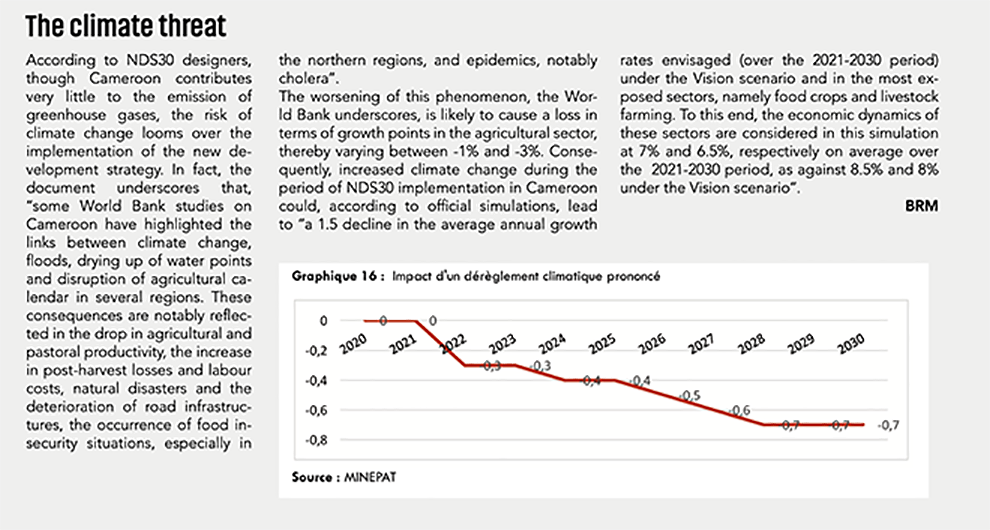The successful implementation of the new development strategy is subject to the lessening of crises underway in the country and timely implementation of some projects.
The Vision scenario is the one on which the achievement of the emergence objectives is based. It is therefore based on a set of key assumptions about the national and international environment. As a result, it faces specific risks of underperformance due to significant changes that could occur in the rea- lization of certain key assumptions’’.
This assumption underscored by NDS30 designers clearly illustrates that the deployment of actions pertaining to Cameroon’s new development strategy will not be hitch-free. This context is even more polluted by some crises whose persistence or deepening will seriously undermine the country’s achievement of emergence.
Among these crises, there are exactions of the Boko Haram islamic sect in the Far North Region. These acts of violence have been going on since the year 2013. According to a World Bank report published in September 2018, since 2013, about 17 000 head of cattle and thousands of sheep and goats were carried away by Boko Haram members in villages of Cameroon’s Far North Region, thereby representing a net loss of more than CFA Francs 3 billion.
The already moribund economic fabric of this part of the country has been washed away, thereby compelling Government to grant the status of an economic disaster zone to the Far North Region, a status accompanied by administrative, tax and customs facilities likely to attract new investments.
Given the insecurity created by terrorists of the Islamic sect, Niger abandoned the project to export its crude oil via the Chad-Cameroon pipeline, thereby resulting in significant revenue loss for Cameroon’s public treasury in terms of transit duties.
In addition to seriously jeopardizing economic activities and investments, Boko Haram is imposing supplementary security expenditure on Government, which would have normally channeled these resources to investment projects that act as growth catalysts.
To understand the magnitude of the security spending thus imposed on the State, budgetary corrective measures taken by the Head of State on 29 May 2019 show an increase of CFA Francs 20 billion to the security allocation, a financial envelope meant for maintaining the deployment of the army in crises-prone regions.
Such is the case for the North-West and South-West Regions which are facing separatist claims since the end of 2016. ‘‘Within the framework of NDS30, a key assumption is the gradual return to peace in these Regions by 2023. Failure to achieve this, the hypothesis is likely to have consequences not only for economic development but also on public finances and the improvement of basic social amenities’’, the document highlights.
Projects within allotted deadlines
Concretely, such a scenario would lead, as we learn, to a less favourable dynamic in the agricultural sub-sector, especially in connection with the drop in activities at the Cameroon Development Corporation (CDC) and Pamol as well as difficulties in product supply and disposal within these regions; decline in BPW activities due to the inability to implement the reconstruction plan of the North-West and South-West Regions; non achievement of the objectives of mobilizing public revenue in this part of the country, etc.
However, in addition to security challenges to be met, the Government of Cameroon should, for successful NDS30 implementation, carry out some projects within allotted deadlines. Such is the case for agricultural projects, of which ‘‘failure to meet the assigned objectives could jeopardize the competitiveness of the industries and chances of diversifying the economy’’, official sources hold.
Similarly, NDS30 specifies that ‘‘ failure to meet the energy schedule could jeopardize the overall sectoral development prospects envisaged’’, with the consequence of having an average annual GDP growth rate over the 2021-2030 period of about 7%, as compared to 8% under the Vision scenario, that is a drop of one point, highlight MINEPAT officials.
A delay in carrying out infrastructural pro- jects will, on its part, lead a decline of 1.1% on the average GDP growth rate projected in 2030.
Priscille Bos’aa






0 Comments